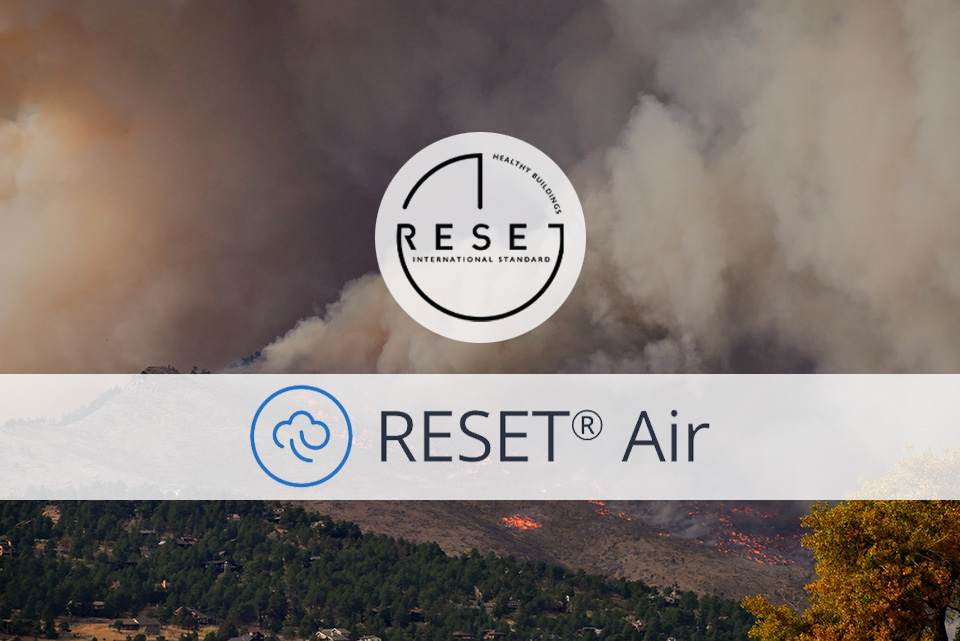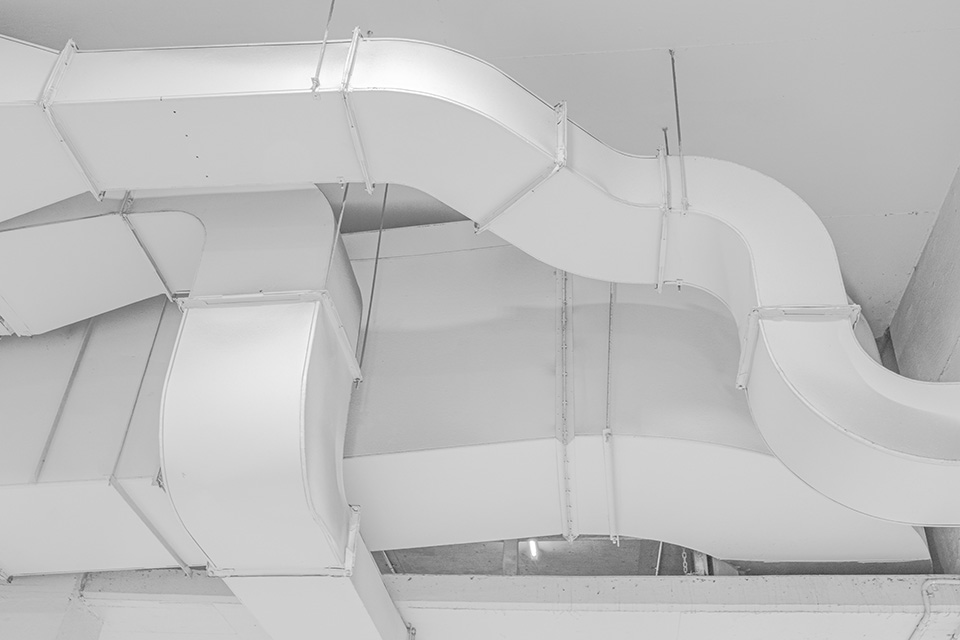7 Steps to Good Indoor Air Quality with RESET Air and how it can help with Forest Fires

As forest fires continue to wreak havoc across North America, air quality has once again become an emergency topic. Prioritizing the health and safety of individuals within indoor spaces is back on the main stage. Yet, the provision of healthier spaces is undermined by a general lack of understanding about the relationship between outdoor and indoor air quality, as well as conflicting messages about ventilation, CO2 reduction, and limiting the intake of particulates from outdoors. Achieving good air quality can be complex - or it can be simple if following a few key principles.

Image Above: Escalating Wildfires (Photo by Malachi Brooks on Unsplash)
RESET Air is a standard for indoor air quality management with a performance and data-driven approach. It was created to address the challenges posed by severe outdoor air pollution without compromising indoor performance.
In this article, we will delve into 7 key facets of RESET Air and why it serves as the gold standard in ensuring healthier indoor environments during forest fires.
01 Management Starts with Good Data
At the core of any successful indoor air quality management strategy lies the need for accurate and reliable data. Without data and metrics from continuous monitoring, it is impossible to tell whether or not an indoor environment has good air quality. Unlike temperature and relative humidity, air quality is not something that can be easily felt.
Indoor air quality monitors serve as the bedrock of data collection, continuously monitoring vital indoor air quality parameters such as particulate matter (PM2.5), CO2, volatile organic compounds (VOC), temperature, and relative humidity, providing real-time and transparent analysis of how a space is performing all day, every day.

Image Above: Vital IAQ Parameters (Photo by Austin Distel on Unsplash; Edited by Ryan Ni)
RESET Air Accredited Monitors pushes this a step further with third-party testing and accreditation of indoor air quality monitors available on the market. The selection and use of RESET Air Accredited Monitors helps projects collect high-quality data, laying the foundation for making informed decisions that ensure optimal indoor air quality for occupants.
Good continuous monitoring data is critical during forest fires seeing as levels of air quality can and will change dramatically over short periods of time. HVAC systems need the data to respond to and balance the need for outdoor air and filtration in order to create the healthiest environment possible for their occupants. Managing health and well-being starts with the management of good indoor air quality data.
See a list of RESET Air Accredited Monitors here: https://reset.build/directory/monitors/air.
02 Define and Assign Responsibilities
If the owner and the occupant of a building or space are not the same, then the responsibility for achieving good indoor air quality is shared between at least two parties (landlord and tenant). Achieving good indoor air quality requires collaborative efforts, as it is nearly impossible for either party to achieve performance targets on their own. Unrealistic expectations and project failures often stem from a lack of well-defined responsibilities.
RESET Air addresses this challenge by providing guidance in defining and assigning the roles and responsibilities of each party involved, establishing a framework that outlines the tasks and obligations of both landlords and tenants in their quest to achieve the best possible indoor air quality performance, cost-effectively.
Responsibilities are assigned by separating the requirements into two different standards for different project typologies: Interiors and Core & Shell. RESET Air for Interiors focuses on what is within the tenant’s control and set of responsibilities, while RESET Air for Core & Shell focuses on what is within the landlord’s control and set of responsibilities.

Image Above: Define Responsibilities (Photo by Cytonn Photography on Unsplash)
By delineating these responsibilities, RESET Air ensures that both parties are aware of their strengths and limitations, enabling them to work together effectively. This shared understanding promotes transparency, accountability, and a harmonious collaboration toward the common goal of maintaining optimal indoor air quality, even during extreme events such as forest fires.
03 Place the Monitors in the Right Location
RESET Air sets monitor deployment requirements, standardizing the number and location of monitors needed to get holistic indoor air quality data from the built environment.
In addition, RESET Air provides guidelines for the different parties in a building, namely the landlord and the tenant. For landlords, positioning monitors in the ducts after the filters allow for the measurement of the air being delivered to tenants by the central systems. This provides valuable insights into how best to manage the central filtration systems so as to control pollutants from forest fires. For tenants, monitors are placed in the breathing zone of the occupied spaces, providing direct visibility into the quality of the air being breathed. The data can then be used to increase local filtration where and when it’s needed.

Image Above: Monitor in the Breathing Zone (Photo by Andrea Artz | Fotogloria; Edited by Ryan Ni)
The built environment requires constant maintenance and upkeep. The different monitoring deployment guidelines for landlords and tenants help eliminate finger-pointing while facilitating communication and collaboration between what are often disparate parties, especially during emergencies such as forest fires.
04 Make Sense of the Data
Data without interpretation is like scattered pieces of a puzzle. Therefore, collecting data is only the first step. Understanding and interpreting it is crucial for effective decision-making.
By partnering with a RESET Accredited Data Provider, building owners and tenants gain access to advanced analytics and reports that transform raw data into actionable insights.

Image Above: Understand the Data (Photo by Carlos Muza on Unsplash)
These insights enable proactive management of indoor air quality during wildfires. For example, the collected data may reveal trends in pollutant levels, trigger alerts when thresholds are exceeded, and guide the implementation of timely interventions. With the support of RESET Accredited Data Providers, building owners can navigate the complexities of indoor air quality management with confidence and precision.
See a list of RESET Accredited Data Providers here: https://reset.build/directory/dataproviders.
05 Use the Data and Automate
In the midst of responding to the multifaceted challenges posed by forest fires, relying solely on manual interventions may result in oversight due to the complexities of managing indoor air quality.
RESET Air acknowledges this need by emphasizing the importance of automation. Building owners can connect RESET Air Accredited Monitors to building systems, enabling real-time adjustments based on the data received. This integration allows for seamless control over ventilation, air filtration, and other critical parameters that influence indoor air quality.

Image Above: Controlling Ventilation Based on the Data (Photo by Mitchell Luo on Unsplash)
Automation ensures continuous protection against the impact of forest fires, even when attention is divided or resources are stretched thin. It serves as a powerful tool for safeguarding the health and comfort of occupants, providing reassurance that measures are in place to address changing conditions effectively.
06 Audit and Certify
Maintaining impartiality in indoor air quality monitoring is the key to establishing trust and confidence among building occupants.
For companies that provide both filtration systems and monitoring solutions, RESET Air Certification helps remove potential conflicts of interest.

Image Above: Data Auditing (Photo by Kaleidico on Unsplash)
By undergoing RESET Air Certification, building owners and tenants demonstrate their commitment to health as well as transparency and accountability, sending a clear message to occupants that their well-being is the top priority.
07 Communicate the results
Effective communication plays a pivotal role in building trust and fostering collaboration between building owners, occupants, and other stakeholders.
RESET Air encourages open and transparent communication of monitored results.

Image Above: Communicate the Results (Photo by Annie Spratt on Unsplash)
Sharing the data collected by indoor air quality monitors enables occupants to have a clear understanding of their indoor air quality and further reinforces the commitment to maintaining a healthy indoor environment. It facilitates collaboration, education, sparks discussions on potential improvements, and fosters a collective effort to combat the challenges posed by forest fires.
Conclusion
In the face of the continued forest fires, indoor air quality is more important than ever and the need for robust indoor air quality management solutions has never been this urgent. RESET Air embodies a commitment to data-driven decision-making, personalized approaches, and collaborative efforts, allowing building owners, tenants, and other stakeholders to proactively create and maintain healthy indoor environments in the face of adversity.
RESET Air can be a transformative solution in creating indoor environments that prioritize health, well-being, and resilience. With a performance and data-driven approach, it is possible to have a safer, healthier future where forest fires no longer compromise our indoor spaces.
About RESET Air
RESET® Air is the world’s first sensor-based, performance-driven building certification program where indoor air quality is monitored and measured in real-time. Buildings and/or spaces are required to consistently maintain healthy indoor air quality at all times, as defined by the Standard. RESET Air is comprised of comprehensive standards for hardware or sensor performance, installation, maintenance and data communication. Learn more about the RESET Air Standard here: https://reset.build/standard/air.
